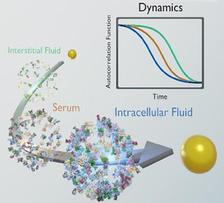Art representation of the experiment: the dynamics of gold nanoparticles in crowded protein environments is probed by XPCS.
We have shown that polymer-coated nanoparticles that are widely studied in the context of nanomedicine show dynamical anomalies in crowded, biological environments. This finding is of utmost importance to understand not only how their structure but also how their colloidal dynamics are affected by physiologically relevant conditions. A characteristic feature of the cytosol of cells is the very high concentration of proteins among other matrix components, often termed macromolecular crowding. Here, the structure and colloidal dynamics of poly(ethylene glycol) (PEG)-coated gold nanoparticles in the presence of bovine serum albumin (BSA) concentrations ranging from 0 to 265 mg/mL are studied with X-ray photon correlation spectroscopy. For protein–nanoparticle mixtures with high BSA concentrations, comparable to intracellular levels, a significant deviation of the apparent viscosity from expectations for pure BSA solutions is found. The findings strongly indicate that the nanoscopic viscous properties of the dense protein solutions are significantly affected by the nanoparticles. At these high concentrations, the colloidal stability of the samples depends on the molecular weight of the coating PEG–ligand, whereas at lower concentrations no differences are observed.
Aggregate 5, e483, 2024
See also DESY news.







